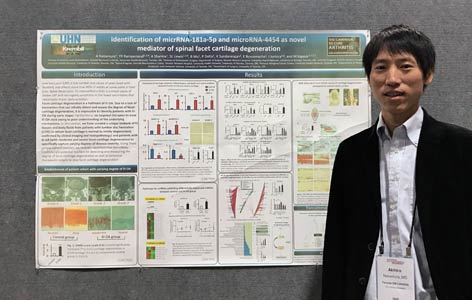Home page Description:
From the bench to the clinic.
Posted On: December 19, 2016

Image Caption:
Conference attendee, Akihiro Nakamura, Postdoctoral Fellow. Supervisor: Dr. Mohit Kapoor, Krembil
Conference: American College of Rheumatology Annual Meeting 2016, Washington DC, USA
Conference Highlight: More and more basic research advances are being translated into new therapies. This year’s ACR/ARHP meeting features cutting-edge research and results of studies that directly affect clinical practice.
Conference Article:
There have been new scientific breakthroughs to stop or delay disease progression in osteoarthritis (OA) research over the last year.
Dr. Louise Reynaud from Newcastle University in UK presented the Zinc-ZIP8-MTF1 axis which is a very novel and promising therapeutic target of OA. The significance of zinc has recently been highlighted in OA research. Dr. Reynaud mentions the expressions of zinc and its transporter (ZIP8) is upregulated in both human and mouse articular cartilage and overexpression of both zinc and ZIP8 markedly aggravates cartilage degeneration. More specifically, upregulated intake of zinc into cells (chondrocytes) through ZIP8 import activates the transcription factor MIF1 resulting in elevated release of cartilage destruction enzymes such as MMP13 and ultimately accelerate cartilage destruction. Blocking this axis dramatically suppressed surgical-induced cartilage destruction in mouse. Dr. Reynaud and her collaborators are now working on a clinical trial to test the protective effect of inhibiting the zinc-ZIP8-MTF1 axis for stopping and delaying cartilage destruction in joints of patients with OA.
Dr. Frank Beier from Western University in Canada has taken a different approach to seek novel treatment for OA. Dr. Beier has been focusing on PPAR which is crucial for lipid and glucose metabolism. In particular, he presented the role of the PPAR-δ mediated pathway in OA. Dr. Beier showed that knockout of PPAR-δ in cartilage of an animal OA model was clearly able to decrease the severity of OA-like cartilage phenotype. Dr. Frank said “Given the fact that previous studies showed the less severity of OA phenotype in a different subtype of PPAR (PPAR-γ) knockout mouse, PPAR family seems to be a promising therapeutic target of OA."
Conference Highlight: More and more basic research advances are being translated into new therapies. This year’s ACR/ARHP meeting features cutting-edge research and results of studies that directly affect clinical practice.
Conference Article:
There have been new scientific breakthroughs to stop or delay disease progression in osteoarthritis (OA) research over the last year.
Dr. Louise Reynaud from Newcastle University in UK presented the Zinc-ZIP8-MTF1 axis which is a very novel and promising therapeutic target of OA. The significance of zinc has recently been highlighted in OA research. Dr. Reynaud mentions the expressions of zinc and its transporter (ZIP8) is upregulated in both human and mouse articular cartilage and overexpression of both zinc and ZIP8 markedly aggravates cartilage degeneration. More specifically, upregulated intake of zinc into cells (chondrocytes) through ZIP8 import activates the transcription factor MIF1 resulting in elevated release of cartilage destruction enzymes such as MMP13 and ultimately accelerate cartilage destruction. Blocking this axis dramatically suppressed surgical-induced cartilage destruction in mouse. Dr. Reynaud and her collaborators are now working on a clinical trial to test the protective effect of inhibiting the zinc-ZIP8-MTF1 axis for stopping and delaying cartilage destruction in joints of patients with OA.
Dr. Frank Beier from Western University in Canada has taken a different approach to seek novel treatment for OA. Dr. Beier has been focusing on PPAR which is crucial for lipid and glucose metabolism. In particular, he presented the role of the PPAR-δ mediated pathway in OA. Dr. Beier showed that knockout of PPAR-δ in cartilage of an animal OA model was clearly able to decrease the severity of OA-like cartilage phenotype. Dr. Frank said “Given the fact that previous studies showed the less severity of OA phenotype in a different subtype of PPAR (PPAR-γ) knockout mouse, PPAR family seems to be a promising therapeutic target of OA."

